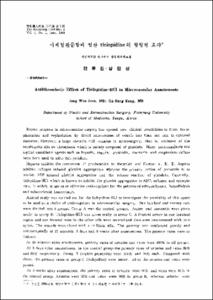미세혈관문합때 염산 Ticlopidine의 항혈전 효과
- Keimyung Author(s)
- Kang, Jin Sung
- Department
- Dept. of Plastic Surgery (성형외과학)
- Journal Title
- Keimyung Medical Journal
- Issued Date
- 1988
- Volume
- 7
- Issue
- 1
- Abstract
- Recent progress in microvascular surgery has opened new clinical possibilities in tissue transplantation and replantation by direct anastomoses of vessels less than one mm in external diameter. However, a large obstacle still remains in microsurgery, that is, occlusion of the anastomosis site by thormbosis which is mainly composed of platelets. Many anticoagulants and topical vasodilatic agents such as heparin, aspirin, persantin, coumarin, magnesium sulfate have been used to solve this problem. Heparin inhibits the conversion of prothrombin to thrombin and Factors V, IX, XI. Aspirin inhibits collagen-induced platelet aggregation wheras the primary action of persantin is to inhibit ADP-induced platelet aggregation and release reaction of platelets, Currently, ticlopidine-HCl which is known to inhibit the platelet aggregation to ADP, collagen and epinephrine, is widely in use as and effective anticoagulant for the patients of atherosclerosis, hemodialysis and subarachnoid hemorrhage. Animal study was carried out for the tichlopidine-HCl to investigate the possibility of this agent to be used as a choice of anticoagulant in microvascular surgery. One hundred and twenty rats were divided into 3 groups Group A was the control groups. Aspirn and persantin were given orally in group B. Ticlopidine-HCl was given orally in group C. A femoral artery in one inguinal region and one femoral vein in the other side were severed and then were anastomosed with 10-0 nylon. The wounds were closed with 4 ㅡ0 black silk. The patency was confirmed grossly and microscopically at 20 minutes, 3 days and 3 weeks after anastomoses. The patency rates were as follows: At 20 minutes after anastomoses, patency rates of arteries and veins were 100% in all groups. At 3 days after anastomoses, in the control group the patency rates of arteries and veins 95% and 85% respectively. Group B (aspirin-prersantin) were 100% and 90% each. Compared with these, the patency rates of group C (ticlopidine) were better, all of the arteries and veins were patent. At 3 weeks after anastomoses, the patency rates of arteries were 90% and veins were 80% in the control group. Arteries were 95% and veins were 90% in group B, whereas arteries were100% and veins were 95% in group C. Therefore, it is concluded that the ticlopidine can be used in microvasular surgery as and anticoagulant of choice.
- Alternative Title
- Antithrombotic Effect of Ticlopidine-HCI in Microvascular Anastomoses
- Keimyung Author(s)(Kor)
- 강진성
- Publisher
- Keimyung University School of Medicine
- Citation
- 전종완 and 강진성. (1988). 미세혈관문합때 염산 Ticlopidine의 항혈전 효과. Keimyung Medical Journal, 7(1), 50–57.
- Type
- Article
- Appears in Collections:
- 2. Keimyung Medical Journal (계명의대 학술지) > 1988
1. School of Medicine (의과대학) > Dept. of Plastic Surgery (성형외과학)
Items in Repository are protected by copyright, with all rights reserved, unless otherwise indicated.
